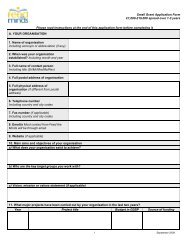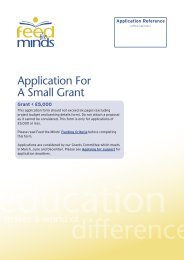Female Genital Mutilation practices in Kenya: - Feed the Minds
Female Genital Mutilation practices in Kenya: - Feed the Minds
Female Genital Mutilation practices in Kenya: - Feed the Minds
Create successful ePaper yourself
Turn your PDF publications into a flip-book with our unique Google optimized e-Paper software.
As <strong>in</strong>dicated <strong>in</strong> <strong>the</strong> previous section,<br />
<strong>the</strong> prevalence of FGM <strong>in</strong> both<br />
Kisii and Kuria rema<strong>in</strong> some of<br />
<strong>the</strong> highest <strong>in</strong> <strong>Kenya</strong>, despite<br />
considerable resources be<strong>in</strong>g<br />
allocated by agencies and <strong>the</strong> government over<br />
recent years to encourage <strong>the</strong> two communities<br />
to abandon FGM. This study was conducted to<br />
<strong>in</strong>vestigate <strong>the</strong> context with<strong>in</strong> which FGM is carried<br />
out <strong>in</strong> Kisii and Kuria to combat FGM and to<br />
provide an assessment of <strong>the</strong> factors which would<br />
need to be taken <strong>in</strong>to account when select<strong>in</strong>g<br />
Alternative Rites of Passage (ARP) approaches for<br />
<strong>the</strong> abandonment of FGM <strong>in</strong> <strong>the</strong>se districts.<br />
The literature review <strong>in</strong>dicated that <strong>the</strong> success<br />
of <strong>in</strong>terventions to encourage <strong>the</strong> abandonment<br />
of FGM depends on <strong>the</strong> cultural context of <strong>the</strong><br />
communities. Consequently, separate case studies<br />
for Kuria and Kisii were developed explor<strong>in</strong>g <strong>the</strong><br />
social context with<strong>in</strong> FGM takes place, <strong>in</strong>clud<strong>in</strong>g<br />
<strong>the</strong> pressures to cont<strong>in</strong>ue <strong>the</strong> practice and <strong>the</strong><br />
factors which contribute to its abandonment. By<br />
analys<strong>in</strong>g <strong>the</strong> way <strong>in</strong> which ARP-type approaches<br />
have been used, it was hoped to identify <strong>the</strong> key<br />
factors necessary for <strong>the</strong> successful <strong>in</strong> <strong>the</strong> use of<br />
ARP-type approaches <strong>in</strong> <strong>the</strong> abandonment of FGM.<br />
This research will <strong>in</strong>form decision-mak<strong>in</strong>g <strong>in</strong><br />
relation to future work by FTM and agencies<br />
<strong>in</strong>volved <strong>in</strong> <strong>the</strong> implementation of programmes<br />
for <strong>the</strong> abandonment of FGM <strong>in</strong> Kuria and Kisii. It<br />
is hoped that it will also contribute to <strong>the</strong> ongo<strong>in</strong>g<br />
debate about <strong>the</strong> role of ARP-type <strong>in</strong>terventions <strong>in</strong><br />
a wide range of contexts.<br />
study obJectives<br />
•• To <strong>in</strong>vestigate current attitudes and<br />
<strong>practices</strong> <strong>in</strong> relation to FGM among men<br />
•• and women at family and community<br />
levels <strong>in</strong> Kisii and Kuria;<br />
•• To <strong>in</strong>vestigate <strong>the</strong> awareness of, and<br />
attitudes towards, ARP approaches to<br />
encourag<strong>in</strong>g <strong>the</strong> abandonment of FGM <strong>in</strong><br />
Kisii and Kuria.<br />
To analyse <strong>the</strong> factors which encourage or enable<br />
<strong>in</strong>dividuals to take decisions to abandon <strong>the</strong><br />
practice of FGM.<br />
study desiGn<br />
The study used a qualitative approach,<br />
explor<strong>in</strong>g attitudes and social <strong>practices</strong> <strong>in</strong><br />
order to understand <strong>the</strong> factors which <strong>in</strong>fluence<br />
decision-mak<strong>in</strong>g <strong>in</strong> relation to FGM. Focus group<br />
discussions (FGDs) and key <strong>in</strong>formant <strong>in</strong>terviews<br />
(KIIs) us<strong>in</strong>g semi-structured questions were<br />
conducted with selected respondents <strong>in</strong> <strong>the</strong><br />
two districts. The respondents were chosen to<br />
represent most of <strong>the</strong> key stakeholder groups<br />
<strong>in</strong>volved <strong>in</strong> FGM <strong>in</strong> <strong>the</strong> two communities.<br />
FGDs were conducted with <strong>the</strong><br />
follow<strong>in</strong>g groups:<br />
•• Mo<strong>the</strong>rs, with separate groups for mo<strong>the</strong>rs<br />
whose daughters: (a) have been cut; (b)<br />
have not been cut; and (c) have been<br />
through an ARP ceremony (<strong>in</strong> Kisii) or who<br />
have attended a rescue camp (<strong>in</strong> Kuria)<br />
Community leaders (men and women);<br />
•• School teachers;<br />
•• Young women over <strong>the</strong> age of 18, with<br />
separate FGDs for: (a) those who have<br />
undergone FGM; and (b) those who have<br />
not undergone FGM;<br />
ee<br />
<strong>the</strong> research: Purpose and design<br />
13.




